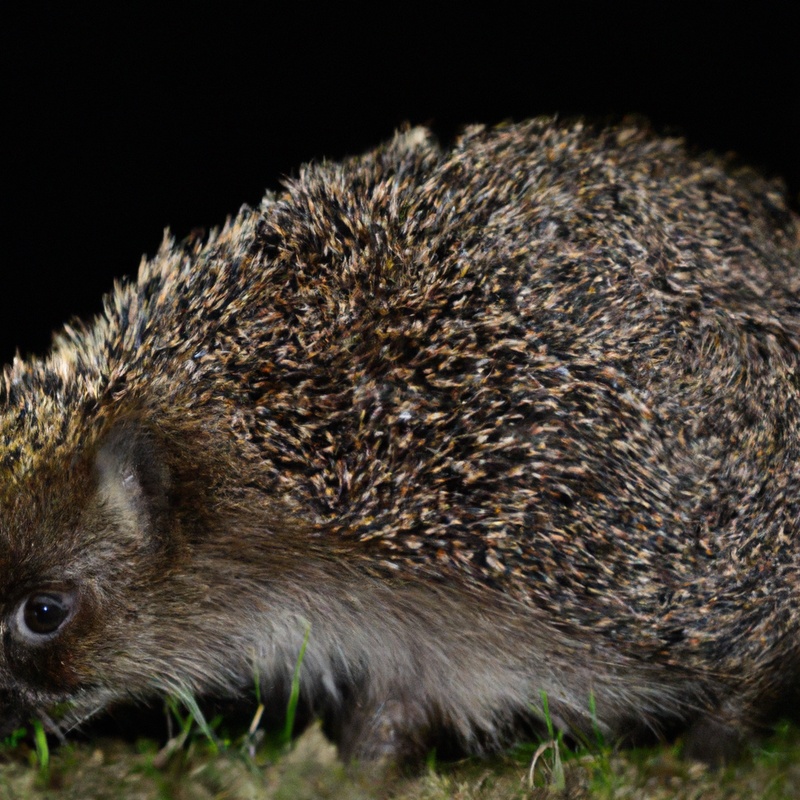How Do Hedgehogs Find Shelter In Urban Landscapes?
Key Takeaways:
- Hedgehogs in urban areas rely on a variety of natural and artificial shelters for protection and safety.
- Access to suitable shelters in urban landscapes is crucial for hedgehog survival and population maintenance.
- Factors such as gardens, parks, and green spaces play a significant role in providing essential shelter options for hedgehogs in urban environments.
- Creating hedgehog-friendly habitats and removing barriers in urban landscapes can improve the availability of suitable shelters for these nocturnal creatures.
Are you curious about how hedgehogs manage to find shelter in the midst of bustling urban landscapes?
It’s quite an intriguing question, isn’t it?
As urbanization continues to reshape our cities, these spiky little creatures have had to adapt and find innovative ways to seek refuge.
In this article, we’ll delve into the factors that influence their shelter choices and explore the various natural and artificial shelter options available to them.
We’ll also uncover some common locations where hedgehogs seek solace in urban areas and discover how we can make our concrete jungles more hedgehog-friendly.
So, let’s dive in and unravel the secrets of hedgehog shelters in our urban world!
| Methods | Advantages | Disadvantages |
| 1. Hedgehog houses | – Provide a safe and secure shelter – Can be placed in gardens or urban green spaces – Mimic natural burrows – Allow for easy monitoring of hedgehog populations | – Require initial investment – Limited capacity – May not be utilized by all hedgehogs |
| 2. Garden features | – Bushes, shrubs, and dense vegetation provide natural hiding spots – Offer protection from predators – Create a suitable microclimate | – Availability and quality of suitable vegetation may vary – Limited space in urban environments – May not provide sufficient protection from extreme weather conditions |
Factors influencing hedgehogs’ shelter choices
Factors such as vegetation cover, proximity to a water source, and absence of disturbances influence hedgehogs’ shelter choices in urban landscapes.
Natural shelters in urban landscapes
Hedgehogs in urban landscapes often seek out natural shelters for protection and safety. These natural shelters can include thick vegetation like bushes, hedges, and tall grasses that provide both cover and food sources.
Additionally, hedgehogs may find refuge in fallen leaves, piles of branches, and even small gaps in walls or under buildings.
Providing such natural shelters in urban environments helps create a conducive habitat for hedgehogs, promoting their presence and well-being.

Artificial shelters created for hedgehogs in urban areas
Hedgehogs in urban areas often struggle to find suitable shelter due to the high levels of human activity and lack of natural habitats. To address this, artificial shelters have been created to provide a safe haven for these adorable creatures.
These shelters, often in the form of specially designed hedgehog houses or boxes, offer protection from predators, extreme weather, and disturbances.
Placing these shelters in gardens or green spaces can make a significant difference in supporting hedgehog populations and creating a more hedgehog-friendly environment in urban landscapes.
Impact of urbanization on hedgehogs’ ability to find shelter
Urbanization has a significant impact on hedgehogs’ ability to find shelter. As cities expand and natural areas are replaced with buildings and roads, suitable habitats for hedgehogs become scarce.
Urban environments are often devoid of the diverse vegetation and natural features that hedgehogs rely on for shelter and protection.
They struggle to find suitable hiding places among the concrete and manicured lawns. This lack of suitable shelter contributes to their declining populations in urban areas.
Characteristics of suitable shelter for hedgehogs in urban settings
Suitable shelter for hedgehogs in urban settings should have appropriate size and dimensions. The shelter should also provide accessible entrance and exit points.
Size and dimensions of shelter spaces
When providing shelter spaces for hedgehogs in urban landscapes, it is important to consider the size and dimensions.
Here are a few key points to keep in mind:
- Entrance size: Ensure that the entrance of the shelter is around 13cm x 13cm, allowing hedgehogs to enter comfortably while keeping out larger animals.
- Internal space: The internal dimensions should be spacious enough for the hedgehog to move around and make a nest. A size of approximately 30cm x 50cm is suitable.
- Height: The shelter should have a height of at least 30cm to provide enough space for the hedgehog to stand up and move around comfortably.
- Ventilation: Adequate ventilation is necessary to prevent the interior from becoming too hot or stuffy. Including small ventilation holes can help with airflow.
By considering these size and dimension factors, you can create suitable and comfortable shelter spaces for hedgehogs in urban environments.

Accessible entrance and exit points in shelter locations
Shelter locations for hedgehogs in urban areas need accessible entrance and exit points.
This allows hedgehogs to come and go easily, ensuring their safety.
Consider low fences or gaps in walls that are big enough for them to pass through but still provide security.
Avoid barriers that are too high or have sharp edges.
Additionally, provide clear pathways and avoid obstacles that may block their access to the shelter.
Protection from predators and disturbances in shelter spots
To ensure protection from predators and disturbances in shelter spots for hedgehogs in urban areas, it’s important to consider a few key factors. First, provide dense vegetation or natural barriers around the shelter area to discourage predators from entering.
Avoid using harmful chemicals or pesticides that could harm hedgehogs or attract predators.
Additionally, create a quiet and undisturbed environment by minimizing noise, human activity, and the presence of pets near their shelter spots. Hedgehogs need safe and secure retreats, so it’s crucial to create shelter options that provide them with protection and peace.
Common shelter locations for hedgehogs in urban areas
Hedgehogs in urban areas often seek shelter in gardens and green spaces, underneath buildings and structures, and near compost bins and piles.
Gardens and green spaces as potential shelters
Gardens and green spaces are ideal shelters for hedgehogs in urban areas.
These areas provide natural cover and protection for hedgehogs to rest and hide during the day.
Hedgehogs can find shelter under bushes, in dense vegetation, or even in piles of leaves and branches.
They may also choose to nest in compost bins or under sheds.
By providing a hedgehog-friendly garden with these features, you can help create a safe haven for these adorable creatures.
Underneath buildings and structures
Underneath buildings and structures, such as sheds, decks, and porches, can serve as ideal shelter locations for hedgehogs in urban areas. These spaces provide protection from the elements and predators, while also offering a cozy and secluded environment for hedgehogs to rest and nest.
Hedgehogs can easily access these areas through small gaps or openings, making them convenient hiding spots for these nocturnal creatures.
However, it’s important to ensure there are no hazards, such as chemicals or sharp objects, that could harm the hedgehogs in these spaces.
Compost bins and piles
Compost bins and piles are common shelter locations for hedgehogs in urban areas.
These natural structures offer warmth, protection, and a steady food supply for hedgehogs.
The decomposing organic matter in compost provides them with insects and other small invertebrates to eat.
Hedgehogs often burrow into the compost, creating a cozy nesting spot.
To create a hedgehog-friendly environment, make sure your compost bins or piles are easily accessible and located in a quiet area of your yard.
Avoid using chemicals or pesticides that can harm hedgehogs.
Making urban landscapes hedgehog-friendly
To make urban landscapes hedgehog-friendly, consider creating hedgehog highways and access points, providing food and water sources, planting native vegetation, minimizing pesticide usage, and avoiding the removal of natural habitat elements.
Creating hedgehog highways and access points
Creating hedgehog highways and access points is essential in ensuring their safety and well-being in urban landscapes.
Here are some simple steps you can take:
- Make small holes or gaps in fences and walls to provide easy access for hedgehogs.
- Connect gardens and green spaces by removing obstacles like solid walls or fences.
- Create hedgehog-friendly corridors with hedgehog holes or tunnels.
- Provide natural cover, such as shrubs and log piles, to create safe passageways.
- Avoid using chemicals and pesticides in your garden, as they can harm hedgehogs.
- Educate your neighbors and community about hedgehog conservation to encourage their participation.
By taking these actions, you can contribute to the preservation of hedgehogs and help them navigate through urban areas more easily.
Providing food and water sources
To provide food and water sources for hedgehogs in urban landscapes, here are some simple steps you can take:
- Leave out a small dish of fresh water in a secluded spot in your garden. This will help hedgehogs stay hydrated.
- Provide natural food sources such as insects and slugs by avoiding the use of pesticides in your garden.
- Create a hedgehog-friendly feeding station by placing a shallow dish of specialized hedgehog food or wet cat food in a quiet corner of your garden.
- Ensure the feeding station is protected from other animals, such as cats and foxes, by using a metal mesh cover. This allows hedgehogs to feed undisturbed.
Planting native vegetation for natural shelter options
One way to provide natural shelter options for hedgehogs in urban landscapes is by planting native vegetation. Native plants not only provide food sources for hedgehogs but also create suitable habitats.
By incorporating a variety of shrubs, trees, and grasses that are indigenous to the area, you can create a diverse and inviting environment for hedgehogs to shelter in.
Avoid using pesticides and chemicals that may be harmful to hedgehogs and their habitat.
Minimizing use of pesticides and chemicals
To minimize the use of pesticides and chemicals in urban landscapes, there are a few simple steps you can follow:
- Choose natural alternatives: Look for organic or natural products to keep your garden pest-free. There are many eco-friendly options available that are safe for hedgehogs and other wildlife.
- Practice integrated pest management: This approach focuses on using a combination of techniques to control pests, such as attracting natural predators, using physical barriers, and practicing good garden hygiene.
- Use pesticides sparingly: If you must use pesticides, make sure to apply them only when necessary and follow the instructions carefully. Avoid using broad-spectrum pesticides that can harm beneficial insects and wildlife.
- Plant native species: Native plants are adapted to local conditions and are less likely to require chemical treatments. They also provide a natural habitat for hedgehogs and other wildlife.
By being mindful of the use of pesticides and chemicals in your urban landscape, you can create a safer and more inviting environment for hedgehogs and other wildlife.
Avoiding the removal of natural habitat elements
To avoid harming hedgehog habitats, it’s important not to remove natural elements they rely on. Firstly, refrain from clearing away piles of leaves, as hedgehogs use them for shelter and nesting.
Secondly, avoid removing fallen branches or logs, as these provide hiding spots for hedgehogs and attract insects for them to eat.
Thirdly, try not to remove dense vegetation, as it offers protection and foraging opportunities. By respecting these habitats, you can help create a welcoming environment for hedgehogs in urban landscapes.
Frequently Asked Questions (FAQs)
Can I keep a hedgehog as a pet in an urban area?
Yes, you can keep a hedgehog as a pet in an urban area.
Hedgehogs can adapt well to living in urban landscapes as long as they have access to appropriate shelter, food, and a secure outdoor space.
It’s important to provide them with a cozy, spacious cage or enclosure, a balanced diet, and regular veterinary care.
Additionally, ensure that your local regulations allow for hedgehog ownership and consider the noise and activity levels of your surroundings to ensure a peaceful environment for your pet.
How can I ensure that hedgehogs are safe while providing shelter?
To ensure that hedgehogs are safe while providing shelter, there are a few simple steps you can take:
- Create a hedgehog-friendly environment by providing natural features like log piles, leaf piles, and dense vegetation for them to hide in.
- Avoid using chemicals in your garden or yard, as these can be harmful to hedgehogs.
- Make sure there are no hazards that could injure or trap hedgehogs, such as uncovered drains or deep trenches.
- If you have a pond, be sure to provide an escape route for hedgehogs, such as a gently sloping ramp.
- Check any outdoor structures, such as sheds or compost heaps, before moving or dismantling them to ensure there are no hedgehogs nesting inside.
Are there any legal implications to creating shelters for hedgehogs in urban areas?
Creating shelters for hedgehogs in urban areas usually doesn’t have any legal implications.
However, it is important to follow local regulations regarding the placement and construction of shelters.
Additionally, make sure the shelter doesn’t interfere with public spaces or cause any harm to other animals.
Consider consulting with local wildlife conservation authorities to ensure you are in compliance with any specific guidelines or restrictions.
Final Verdict
Hedgehogs face unique challenges when it comes to finding shelter in urban landscapes.
However, there are several factors that influence their choices, including natural and artificial shelter options.
Characteristics of suitable shelter spaces include size, accessible entrance and exit points, and protection from predators and disturbances.
Common shelter locations in urban areas include gardens, underneath buildings, and compost bins.
To make urban landscapes hedgehog-friendly, creating hedgehog highways, providing food and water sources, planting native vegetation, minimizing pesticide use, and preserving natural habitat elements are key.
To ensure the safety of hedgehogs, it is important to avoid keeping them as pets in urban areas and consider any legal implications when creating shelters.
By implementing these measures, we can create a welcoming environment for hedgehogs and help protect their population in cities.








